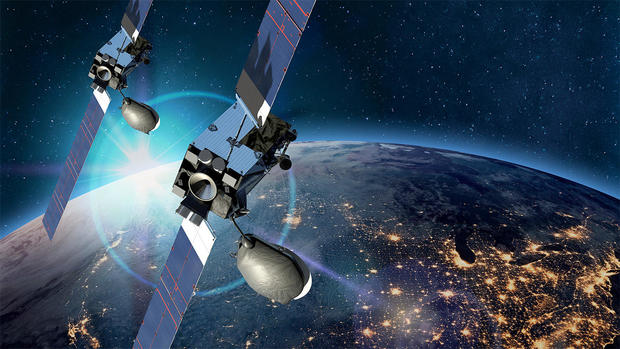Atlas 5 rocket launches twin SES communications satellites
A United Launch Alliance Atlas 5 rocket blasted off from Cape Canaveral, Florida, Tuesday afternoon, and boosted two SES C-band communications satellites into orbit, the second and third in a series of five that will deliver television and radio to millions of American homes.
The Atlas 5's Russian-built RD-180 first-stage engine roared to life at 5:36 p.m. EDT, followed by ignition of three Northrop Grumman solid-propellant strap-on boosters, instantly pushing the 196-foot-tall rocket away from pad 41 at the Cape Canaveral Space Force Station.
Arcing to the east over the Atlantic Ocean, the Atlas 5 raced through the speed of sound 40 seconds after liftoff, smoothly accelerating as it consumed propellant and lost weight.
The three strap-on boosters burned out and fell away two minutes after launch and two-and-a-half minutes after that, the RD-180 shut down, the first stage fell away and the climb to space continued with a single hydrogen-fueled Aerojet Rocketdyne engine powering the Centaur second stage.
The flight plan called for three Centaur engine firings over five-and-a-half hours to put the SES-20 and 21 satellites into a circular geosynchronous orbit, 22,300 miles above the equator. At that altitude, satellites take 24 hours to complete one orbit and thus appear stationary in the sky — ideal for communications stations.
The Boeing-built SES-20 and 21 satellites will join the SES-22 relay station, built by Thales Alenia Space and launched by SpaceX last June. Northrop Grumman is building two more SES satellites, SES-18 and 19, that will be launched later this year or early next.
The sixth in the series, SES-23, is being built by Thales Alenia Space to serve as a ground spare.
The satellites are the result of a Federal Communications Commission directive to free up the lower part of the C-band spectrum, traditionally used by radio and television relay stations, for use by emerging 5G broadband networks.
"To meet the FCC's deadline of clearing C-band spectrum across the U.S., SES has ordered six satellites to provide the necessary capacity for our existing customers," the company said in a statement.
SES-20, 21 and similar satellites will operate in the upper region of the C-band spectrum to make room for 5G transmissions. SES and other existing C-band satellite operators are being reimbursed for the cost of building and launching new satellites by companies bidding for slices of the 5G spectrum.
Steve Collar, CEO of SES, said the five operational satellites being launched, along with the ground spare, will meet the FCC deadline while ensuring continuity for the company's millions of broadcast customers.
"These satellites are going to be operational within just a few weeks of launch, which is fantastic," Collar said of SES-20 and 21.
"They're part of a much broader plan, five satellites that we will launch in order to ... deliver on the plan that we have for the clearing of spectrum, but also, most particularly, to support the ongoing services of our customers and their neighborhoods."






